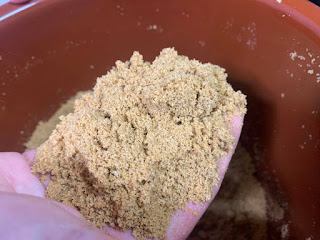My first check on my nukadoko revealed…not very much. There was a warm nutty smell with a bit of spice; however, the vegetables hadn’t broken down very much, and the texture didn’t seem quite right. It wasn’t the “coarse, wet sand” described in Kansha. A consult with Elizabeth, a.k.a. my Pickle Pot Advisor, confirmed that more beer was needed and to rebury the vegetable scraps to see what would happen. Other recommendations she had: add more nuka to increase volume; letting the veg “sweat” after being salt-rubbed before immersion in the pot. This draws out moisture locked in the vegetables, which in turn enriches and moistens the pot, and it makes room for the microbe-rich liquid that will be drawn into the vegetables. She also recommended keeping the liquid drawn out and add it, too, to the pot with the veg.
I added more beer directly to the pot to adjust the texture and reburied the veg. A check on Day Three revealed a sweaty lid and a slightly sour smell. I flipped and flopped and scooped the nuka. I patted the top flat, but Elizabeth later told me this was NOT what should be done at this stage. It gets patted flat ONLY when actively pickling. When NOT pickling, a rougher, loose top is good as it allows for air to flow.
Sweat on the inside of the lid! Yes!
The next day the scent was slightly sour, and there was sweat on the inside of the lid. Hooray! I did the flipping, flopping, and scooping and left it to rest.
Concerned about rising temperatures combined with rain and fluctuations in humidity – anywhere from 70 – 97% – I replaced the veg scraps, letting them “sweat” a bit as my PPA recommended. Over the next few days, there was only a little or no sweat on the inside of the lid, but the scent steadily moved toward sour. There was no visible liquid, but the nuka was becoming damper and damper to the touch.
Ginger and veg hanging out, breaking down.
On my next veg switch, four days later, I added a hunk of ginger. I’d been re-reading the Kansha recipe (I assume I will be able to recite those pages by heart soon) and one of Elizabeth’s recommendations for flavor and to offset sourness is a peeled hunk of ginger. I let it and the scraps sweat while I did the dishes and prepared a few things ahead of the heat for lunch and dinner. By the time I returned my attention to them, there was a bit of fluid in the bottom of the scrap-sweating bowl. Everything went in and got buried. When I checked that evening again, the sour scent was less and there was some sweat on the lid again. The veg looked a bit more wilted, as did I at 96% humidity after a long day.
The nuka had gone dark and began to get damp.
Since then, the nukadoko has been steadily becoming damper but maintaining its pleasantly sour smell. Three days later, I switched the veg once more. I’ve taken to double checking during the day now as the weather fluctuates between heat and rain, high and lowish humidity. I worry, but I’m also curious to see how the nukadoko faires in different conditions. Elizabeth is sending along an infusion from her nukadoko, believing my nukadoko and I are both ready, so here we go to the next stage!
